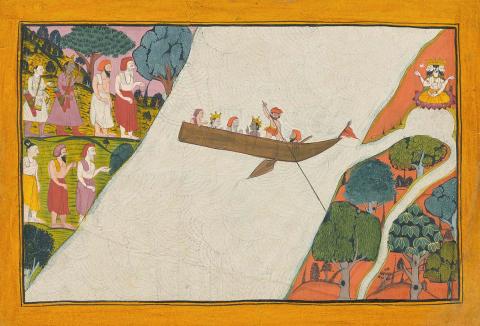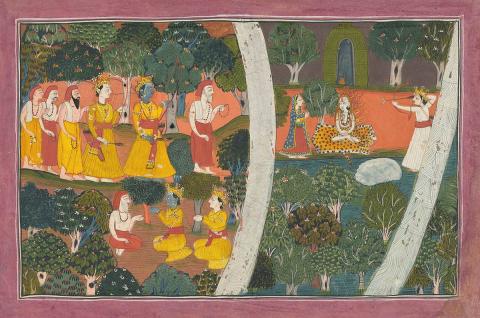UNKNOWN; Two paintings from the Ramayana
By Tarun Nagesh
Believed to have been composed between 400 and 200 BCE by the sage Valmiki, the Ramayana is a tale of epic proportions, featuring an enchanting cast and chronicling wondrous events that rival any historical legend. Originally a poem, numerous versions evolved as it was translated into the many languages of India, and it gradually grew into around 25 000 verses.(1) Along with the Mahabharata, it is the most celebrated of Hindu tales, detailing many facets of social and religious practice. Literally meaning ‘history of Rama’, the Ramayana tells the story of the young and powerful prince Rama (an incarnation of the god Vishnu) who is plotted against by his stepmother and banished to the forest to live as an ascetic for 14 years. The text follows the prince and his brother, Lakshmana, on their quest to recover Rama’s wife, Sita, after her abduction by Ravana, the king of the raksasas (malevolent beings). The pair encounter austere sages along the way and face all manner of mythical confrontations, culminating in a monumental battle between the raksasas and Rama, who is aided by a colossal army of monkey.(2)
In the many painted renditions of the epic, a single composition can include a number of scenes to convey part of the narrative. This pair of miniature paintings (The sage tells Rama and Laksmana of Kama’s attempt to distract Shiva c.1800 and Visvamitra crosses the Sarayu with Rama and Laksmana c.1800) from the Himalayan region of Mandi, an area that followed the Pahari style, demonstrates this approach. In one painting, a sage leads Rama and Lakshmana to a sacred hermitage between two rivers, known to have been the location where the god Shiva himself once meditated. The sage is depicted in the lower left of the work, recounting the story of the great god’s visit to the two princes. The story is illustrated on the right between the two rivers, showing Shiva seated on a leopard skin and deep in meditation. On the right is the god of love, Kama, sent by the gods to assist Shiva to fall in love with Parvati, depicted on the left. However, Kama tries to shoot his love arrows at Shiva in an attempt at distracting the meditating god. Furious after realising this, Shiva opens his third eye and reduces Kama to ashes.
The second painting shows the two princes led by the sage Visvamitra. Below, the sages appear again as they leave the princes’ company on the banks of the Sarayu River. As they reach the middle of the river, Rama notices an unusual and increasingly loud gushing sound. The sage explains that the god Brahma created Lake Manasovar at the base of Mount Kailash, from which the Sarayu spontaneously flows, and this is the sound it makes as it converges with the waters of the Ganges. On the right-hand side of the painting appears the four-headed Brahma. He sits on a lotus throne at the head of a pool of water from the river, representing the story Visvamitra has recounted, with the lake flowing from the Sarayu to the Ganges below.
While the Ramayana remains a quintessential epic, it also functions as a series of lessons in human and religious values, conveying the concept of dharma (duty, righteous path) and Hindu devotion. This pair features the Hindu Trimurti (trinity) through its illustrations of Brahma, Vishnu (incarnate as Rama) and Shiva, personifying the central cosmic forces of creation, preservation and destruction. They depict scenes from a text that is highly influential throughout the world, which has been adapted to suit both Buddhist and Islamic beliefs and is celebrated through art, architecture, literature, festivals and dance throughout Asia.
Tarun Nagesh, Artlines 4-2013, p.43.
Endnotes
1 Garrett Kam, Ramayana in the Arts of Asia, Select Books, Singapore, 2000, p.4.
2 The widely celebrated monkey deity Hanuman appears as a central character in the tale after Rama joins forces with the monkey army.

